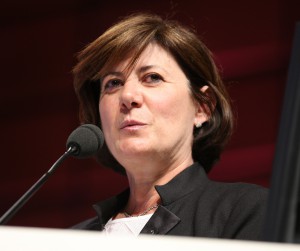Comprehensive personalised imaging transforms cardiothoracic disease management
Watch this session on ECR Live: Sunday, March 8, 8:30–10:00, Room E1
Tweet #ECR2015E1 #NH17
Besides personalised imaging, a new paradigm is emerging in radiology that should re-shape clinical practice and benefit the patient immensely. Supported by new technologies that enable radiologists to image the body faster and better, radiologists are now trying to broaden their focus during examinations.
If there is a field where these advances make a tremendous difference, it is cardiothoracic imaging, an area where diseases are more often than not intertwined. Cardiovascular and chest radiologists will explain how the comprehensive personalised approach impacts their work and try to convince radiologists on both sides to take an interest in the other, in a New Horizons session on Sunday at the ECR.
For years, the trend was for radiologists to subspecialise as much as they could. Cardiovascular radiologists and chest radiologists would focus on their own area with little or no interest beyond that. But among these subspecialists, an increasing number are now changing their approach, as mounting evidence shows that diseases of the heart and chest are very often related, according to Dr. Christian Loewe, deputy head of the section of cardiovascular and interventional radiology at the Medical University of Vienna, Austria.

Dr. Christian Loewe is deputy head of the cardiovascular and interventional radiology section at the Medical University of Vienna, Austria.
“In the past patients were investigated by either focusing on chest or cardiac diseases. This choice was mainly driven by their first clinical examination. However, there are a lot of situations and diseases where chest problems are caused by cardiac diseases and vice versa. There’s a huge interaction between heart and chest, and that’s why it’s interesting and important to look at this relationship in more detail today,” he said.
To prove his point, Loewe, a cardiovascular radiologist, will talk about acute and chronic chest pain during the session. Some of the most severe causes of chest pain are due to cardiovascular diseases, including myocardial infarction or acute aortic diseases. However, acute chest pain can also be caused by a number of pulmonary diseases, including pulmonary embolism, pneumonia and others. Therefore, radiologists must learn the different life-threatening disorders that cause chest pain, whether they are respiratory or cardiovascular.
Radiologists must also understand the role of imaging in acute and chronic chest pain, and how to read scans in a new light. “We should not focus on one single organ, for instance coronary arteries, but we should rather try to see the heart and do a complete assessment of anatomy and function. Furthermore, imaging examinations now have very good quality, and CT of the heart also depicts the lung in exquisite detail – just as CT of the lung or chest depicts the heart. So we have to learn to look at other organs at the same time,” he said.
Technology is driving medicine, and it has more impact on radiology than any other medical specialty. Prof. Martine Rémy-Jardin, professor of radiology and head of the department of cardiothoracic imaging at the University Centre of Lille in France, who will also take part in the session, will stress this point in her presentation on the early detection of cardiothoracic disease in smokers.
“Ten years ago, it was impossible to detect coronary calcium because machines did not offer this possibility. But since then, technological advances and in particular shorter rotation time in CT have enabled us to study the heart in the diastole phase, when it is relaxing, so we can now visualise very thin vessels and calcium deposits in those vessels,” she said.

Prof. Martine Rémy-Jardin is head of the department of cardiothoracic imaging at the University Centre of Lille in France.
It is important to examine the patient carefully because patients at risk of cardiovascular diseases are usually at risk of atherosclerosis or lung cancer too. “If a patient comes in for a lung cancer examination, we should try to find ways to examine him/her for cardiovascular disease in the same examination. In patients suffering from a known existing coronary disease, we should also look for signs of lung cancer because many of them are smokers and we’re talking about the same risk population,” Loewe said.
Additionally, there are chest diseases that do not have a major shared risk population but can cause secondary cardiac problems, such as emphysema, chronic obstructive pulmonary disease (COPD) or asthma. If these diseases are present for a long time, patients may suffer from secondary cardiac disease, which may limit their life expectancy. Despite the well-documented atherogenic effects of smoking, the radiologist’s attention remains directed mainly towards the depiction of emphysema and airways disease in smokers. However, recent guidelines for COPD patients have underlined the major impact of cardiovascular comorbidities, recommending that they should be actively looked for and appropriately treated if present, according to Rémy-Jardin.
Cardiovascular comorbidities in smokers include atherosclerotic coronary disease and ischaemic cardiopathy, atheromatous lesions of the aorta and supra-aortic vessels, which can trigger stroke. They also include the consequences of pulmonary vascular diseases on the right heart and much more.
Theoretically, this recommendation could have a major impact on the way chest CT examinations of smokers are performed and reported. These represent a common category of patients for specialised but also non-specialised radiologists. “The impact on the clinician’s understanding of patient symptoms is important because a given symptom can have a pulmonary or cardiovascular origin, such as those encountered in the presence of chronic or acute dyspnoea, chest pain, haemoptysis or hypoxemia,” Rémy-Jardin said.
In the pretherapeutic assessment of bronchopulmonary carcinoma, chest radiologists should look for signs of COPD, smoking-related infiltrative lung disease and cardiovascular comorbidities. Depending on the location and extent of lung carcinoma, the presence of signs suggesting cardiovascular invasion are also worth reporting.
“During surgical procedures for lung disease, for instance lymph node sampling, there is a risk of presurgical and postsurgical stroke. Therefore, we have to inform the surgeon about the number, thickness and location of atherosclerotic plaques on the ascending aorta and collaterals, as well as at the level of the aortic arch. We must also inform the surgeon about the presence of coronary calcifications, even in asymptomatic patients. It is not exceptional to depict sequellae of myocardial infarction in the absence of any history that might influence pre-anaesthetic assessment,” she said.
Radiologists must also warn the surgeon when they identify a patent foramen ovale prior to a lobectomy or right pneumonectomy. When examining coronary disease with CT, radiologists should also look for bronchopulmonary carcinoma, signs of COPD or smoking-related infiltrating disease in the explored volume, depending on the age of the patient and their degree of smoking.
Hopefully, the session will raise awareness among radiologists about the necessity to think outside the box. “If you’re a cardiac radiologist you should also know about the chest. This is the main aim of the session. Many diseases of the heart cause lung problems and vice versa,” said Loewe, who will also discuss the emerging role of CT in diagnosing suspected myocardial infarction in patients with severe chest pain.
“It’s not in the guidelines yet, but there are a lot of papers underlining that CT could be very important here. Some myocardial infarctions cannot be diagnosed by looking at the ECG, so patients with suspected myocardial infarction who showed no sign on ECG can only be diagnosed or ruled out after eight to ten hours looking at the laboratory values. But the longer we wait, the more complicated it becomes to perform revascularisation. Early CT might therefore be very helpful in those patients, by helping them to either undergo revascularisation in time or be discharged earlier,” he said.
New Horizons Session
Sunday, March 8, 08:30–10:00, Room E2 #ECR 2015E2 #NH17
NH 17 Comprehensive personalised imaging of cardiothoracic diseases
» Chairman’s introduction: how to prepare for the future?
T. Benedek; Targu Mures/RO
» Patients with acute and chronic chest pain
C. Loewe; Vienna/AT
» Patients with acute shortness of breath
J. Bremerich; Basle/CH
» Patients with chronic shortness of breath
E.J.R. van Beek; Edinburgh/UK
» Early detection for cardiothoracic disease in smokers
M. Rémy-Jardin; Lille/FR
» Panel discussion: Comprehensive imaging and education in cardiothoracic diseases


